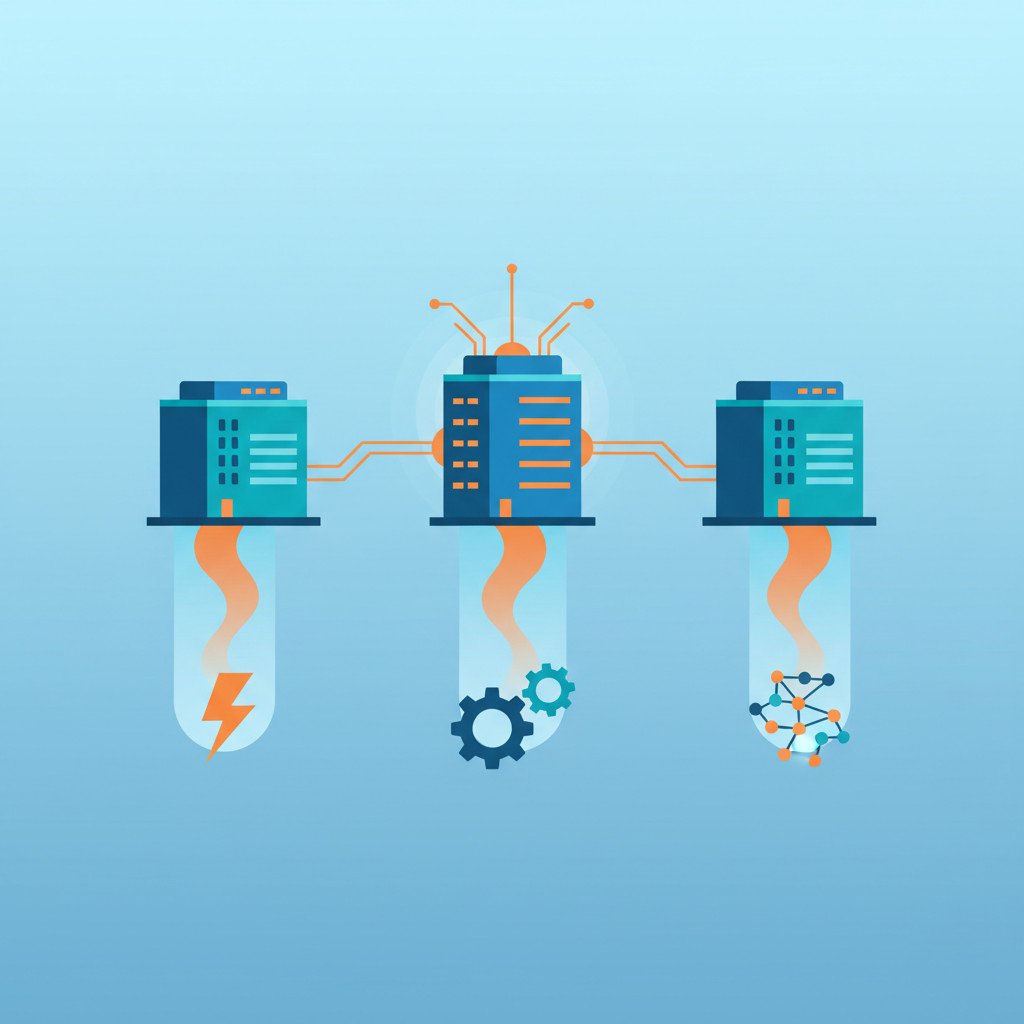AI data centre interconnect now sits at the heart of modern IT infrastructure, driving bandwidth, latency, and scale demands. Operators need predictable, high-capacity links because AI training and inference move massive datasets across facilities.
Cisco’s new routers aim to close this gap with coherent optics, deep buffering, and line-rate encryption. As a result, enterprises can scale AI workloads across campuses and cloud regions with lower bottlenecks and simpler operations.
Moreover, because these solutions combine high port densities and programmable Silicon One ASICs, they support observability, post-quantum resilient encryption, and software flexibility such as SONiC and IOS XR integration, which together reduce vendor lock-in risks, accelerate time to service, and help hyperscalers plus service providers deploy multi-hundred gigabit fabrics that handle over 20 billion packets per second and scale interconnect bandwidth into the exabyte-per-second range for emerging AI workloads spanning training, inference, and data pipelines and enable richer data gravity models for multi-site ML orchestration.
What is AI data centre interconnect
AI data centre interconnect describes the high-capacity links and systems that connect multiple data centres for AI workloads. It combines routers, coherent optics, deep buffers, and transport software to move huge datasets quickly. Because AI training and inference span sites, these links reduce latency and avoid I/O bottlenecks. As a result, teams can distribute models, share datasets, and orchestrate pipelines across regions.
Why AI data centre interconnect matters
AI workloads create unique traffic patterns and extreme bandwidth needs. Therefore interconnects must offer massive port densities, predictable latency, and strong security. Cisco’s 8223 highlights this shift by delivering many 800G ports and deep buffering, helping operators scale multi-hundred gigabit fabrics. Learn more about how this design addresses AI bottlenecks here: this article.
Moreover, software flexibility matters because networks must adapt fast. Open-source SONiC and other control planes let engineers automate fabric behaviour and monitor performance. For an overview of the 8223 router and software choices see this explainer: this explainer. Also, the P200 Silicon One chip underpins scale and programmability; read about the P200 and performance claims here: this page. For code and community resources check SONiC on GitHub: this GitHub link.
Key functions and importance
- Move training data between sites with low latency and high throughput
- Aggregate multi-hundred gigabit flows from GPU clusters and storage
- Provide deep buffering to absorb distributed model synchronization bursts
- Secure links with line-rate encryption and post-quantum resilient algorithms
- Enable programmability for observability and traffic engineering
- Reduce vendor lock-in through open software and standard optics
AI data centre interconnect transforms how teams plan scale, because it aligns network design with AI compute gravity.

Challenges in AI data centre interconnect
Designing AI data centre interconnect brings several practical challenges. Latency and bandwidth sit at the top of the list because AI training moves massive datasets between sites. Therefore operators must balance throughput with predictable latency to avoid stalled synchronisation. At the same time, physical distance and optics constraints complicate long-haul links.
Common technical pain points
-
Latency and jitter
- High-performance AI needs low, predictable latency for synchronous training. However, long distances and packet reordering increase jitter and slow convergence.
-
Bandwidth and oversubscription
- AI clusters generate bursts of traffic that exceed traditional fabrics. As a result, operators need multi-hundred gigabit ports and deep buffering to absorb spikes.
-
Synchronisation and consistency
- Distributed training requires tight clock and model state sync. Otherwise checkpointing and gradient exchange create performance cliffs.
-
Security and encryption
- Data in motion must stay confidential, especially across public routes. Therefore line-rate encryption and post-quantum resilience matter for long-term risk reduction.
-
Interoperability and vendor lock-in
- Networks must run standard optics and open control planes. Otherwise vendors force proprietary stacks, which limits flexibility and raises costs.
-
Observability and automation
- Teams need detailed telemetry to diagnose microbursts. Moreover, automation reduces human error and speeds troubleshooting.
-
Cost, power, and space
- High-density 800G ports consume power and require cooling. Thus capital and operational budgets must reflect the new scale.
Addressing these challenges demands holistic design. You must align compute, storage, and network choices. For software-driven control and community tools, see SONiC on GitHub. For general context about DCI challenges, review this overview: Data center interconnect.
AI data centre interconnect comparison
Below is a compact comparison of leading AI data centre interconnect technologies. These entries highlight speed, latency, security, and common use cases. Therefore you can match options to workload needs and growth plans.
| Technology | Typical speed | Latency characteristics | Security features | Typical use cases | Notes on scalability and cost |
|---|---|---|---|---|---|
| Cisco 8223 (Silicon One P200) | 64 ports of 800G, up to 51.2 Tbps fabric | Very low and predictable for routed flows; deep buffering reduces jitter | Line-rate encryption, post-quantum resilient algorithms | Long-haul DCI for hyperscalers, multi-site AI training | High density reduces footprint, higher capex but lowers long-term Opex |
| Broadcom Jericho 4 based routers | 400G to 800G ports depending on platform | Low latency at scale, optimized for large routing tables | Standard IPsec, MACsec; vendor-specific enhancements | Large service provider and cloud backbone interconnects | Scales well in route capacity; licensing can increase cost |
| 800G coherent optics (long-haul DWDM) | 800G per lambda; pluggable coherent links | Latency driven by distance; coherent optics add minimal overhead | Encrypts at line rate when paired with routers; fiber security depends on ops | Inter-site links up to 1,000 kilometres for training/inference | Enables long reach without regeneration; optics add capex but lower repeaters |
| Hyperscaler switch fabrics (Spectrum, Tomahawk families) | 100G to 400G per port, aggregated to multi-Tbps | Extremely low microsecond-level latency inside fabrics | Host and fabric-level encryption options; telemetry-rich | Rack and pod level aggregation, intra-data-centre AI clustering | Cost-effective for dense leaf-spine; limited long-haul reach |
| Software-defined interconnects (SONiC + EVPN/MPLS) | Speed varies by hardware, supports 100G to 800G | Latency varies by hardware; software adds flexibility | Depends on underlying hardware; supports standard encryption | Automation-first deployments, observability, hybrid cloud | Lowers vendor lock-in; requires skilled ops and integration effort |
Related keywords and concepts: Cisco 8223, Silicon One P200, deep buffering, 800G coherent optics, post-quantum encryption, SONiC, vendor lock-in. As a result, this table helps you choose the right AI data centre interconnect approach for your latency, throughput, and security goals.
Benefits of AI data centre interconnect for businesses
AI data centre interconnect unlocks tangible business gains. By linking sites with high-capacity, low-latency fabrics, companies accelerate data movement. As a result, teams train models faster and deliver features sooner.
-
Increased efficiency and utilization
- Interconnects let compute and storage balance across sites. Therefore idle GPU capacity drops and utilisation rises. For example, a cloud provider can shift training jobs to underutilized regions and reduce wait times.
-
Faster data processing and shorter time to insight
- High-throughput links move terabytes quickly. Consequently end-to-end pipelines finish sooner and models iterate faster.
-
Improved AI model training and convergence
- Low, predictable latency helps synchronous training scale. Moreover deep buffering absorbs bursts during gradient exchanges, which reduces stalled epochs.
-
Enhanced security and compliance
- Line-rate encryption and post-quantum resilient algorithms protect data in motion. Thus businesses meet privacy and regulatory requirements for cross-border datasets.
-
Operational agility and lower vendor lock-in
- Open control planes such as SONiC enable automation and multi-vendor deployment. Therefore teams adapt quickly and avoid costly vendor constraints.
-
Better disaster recovery and workload mobility
- Because sites stay tightly coupled, failover becomes faster. For instance, an enterprise can shift inference traffic to a secondary site within seconds, lowering downtime.
Real-world momentum underscores these benefits. Major hyperscalers, including Microsoft, already test or deploy high-density DCI solutions. As a result, early adopters cut training cycles, lower operational cost, and unlock richer AI services. In short, AI data centre interconnect aligns network scale with AI ambitions, enabling businesses to innovate faster and operate more reliably.

Future trends in AI data centre interconnect
AI data centre interconnect will evolve rapidly as AI demands grow. Therefore networks must adopt higher port speeds, smarter optics, and software-first control. As a result, enterprises can move larger datasets with predictable latency and lower operational overhead.
Key innovations to watch
- Terabit and beyond fabrics
- Hardware will push past 800G ports to 1.6T and terabit lanes. Consequently aggregation and spine layers will carry multi-petabit flows.
- Integrated coherent photonics
- Coherent optics will become more pluggable and power-efficient. Thus long-haul links up to 1,000 kilometres will cost less per bit.
- In-network compute and AI-aware routing
- Networks will offload tasks such as aggregation and compression. Moreover routers will optimize paths for gradient exchange and model sync.
- Advanced buffering with HBM memory
- Deep buffers using HBM will absorb training microbursts. Therefore synchronous training scales with fewer stalls.
- Open software and intent-driven automation
- SONiC and intent APIs will automate fabric behaviour. As a result teams will reduce manual tuning and speed deployment.
- Enhanced telemetry and observability
- Telemetry will provide sub-millisecond visibility into microbursts. Consequently operators will detect and fix hotspots faster.
- Stronger cryptography and compliance-ready links
- Line-rate encryption will adopt post-quantum algorithms. Thus long-term data protection will meet stricter regulations.
In short, AI data centre interconnect will shift from raw capacity to intelligent fabrics. Together these changes will let enterprises scale AI workloads more reliably and cost-effectively.
Best practices for AI data centre interconnect
Implementing AI data centre interconnect demands careful planning and cross-team coordination. Start with measurable goals such as target latency, throughput, and recovery time. Then align network design with compute and storage architecture.
- Define clear performance targets
- Specify required throughput per GPU cluster, acceptable latency, and jitter limits. Moreover include burst profiles for synchronous training.
- Plan capacity with headroom
- Design for peak loads and future growth. Therefore provision extra port capacity and consider 800G to 1.6T uplinks.
- Choose the right optics and reach
- Match coherent optics to distance and loss budgets. As a result you avoid unnecessary regeneration and reduce cost per bit.
- Prioritise security and compliance
- Enable line-rate encryption and consider post-quantum resilient algorithms. Also enforce key management and audit trails for cross-border data flows.
- Adopt open software and automation
- Use SONiC or intent-driven controllers to automate routing, telemetry, and policy. Consequently operations teams reduce manual errors and speed rollouts.
- Deploy enhanced telemetry and observability
- Collect fine-grained metrics and flow traces. Then use telemetry to detect microbursts and tune buffers.
- Validate with staged testing
- Run synthetic workloads and full-scale rehearsal tests. Moreover include failover drills to measure recovery time.
- Optimize for power and cooling
- High-density routers need proper thermal planning. Therefore size power feeds and cooling before installation.
For detailed specs and recent product guidance, review Cisco’s announcement on AI routing systems and the SONiC project for software options.
AI data centre interconnect has become essential for modern AI infrastructure. It removes bottlenecks and enables large-scale training. Cisco’s 8223 shows how higher port density, coherent optics, and line-rate encryption address these challenges. As a result, networks can scale across regions with predictable performance.
Throughout this article we covered benefits, challenges, best practices, and future trends. Businesses gain faster training, higher utilization, and stronger security. However, they must manage latency, power, and interoperability. Therefore planning, telemetry, and staged testing matter.
Enterprises should evaluate AI DCI as a strategic investment. Start with clear targets, choose open software, and plan for growth. Moreover, adopting modern routers and coherent optics helps reduce operational friction and unlocks new AI capabilities.
EMP0 is a US-based company focused on AI and automation solutions. They build AI-powered growth systems and deploy securely under clients’ infrastructure. For more information, explore EMP0 online: Website; Blog; n8n. You can follow them on Twitter at @Emp0_com and read their posts on Medium at medium.com/@jharilela.
Looking ahead, intelligent fabrics, terabit lanes, and in-network compute will reshape enterprise architectures. Consequently organisations that invest early will shorten time-to-insight and stay competitive. In short, AI data centre interconnect is not optional for AI-first companies. Invest wisely and iterate fast.

